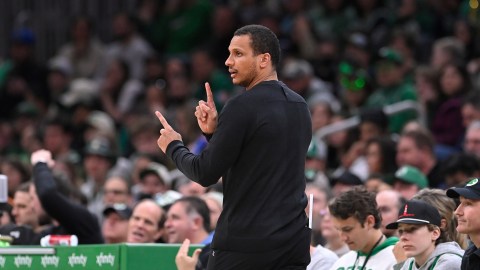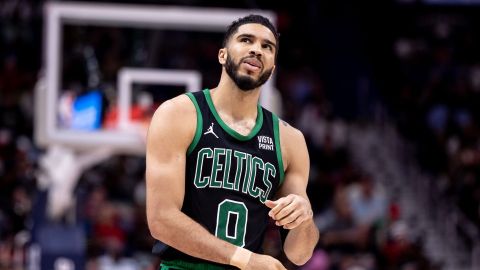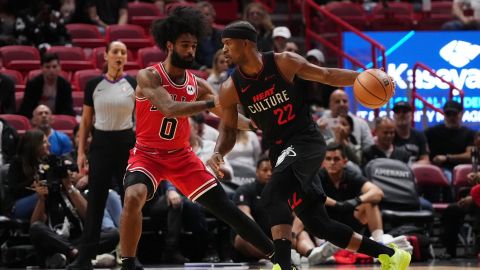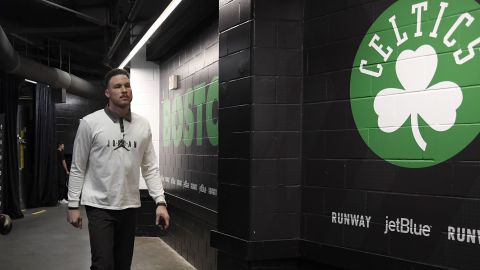 WALTHAM, Mass. — Early in the season, Jeff Green could not escape the locker room after games without addressing the media. Befitting his stature on the team, not to mention his play to that point, Green was one of the unofficial spokesmen of the Boston Celtics.
WALTHAM, Mass. — Early in the season, Jeff Green could not escape the locker room after games without addressing the media. Befitting his stature on the team, not to mention his play to that point, Green was one of the unofficial spokesmen of the Boston Celtics.
Over the last few weeks, however, Green has been able to slip out without so much as a word. It’s not that he hasn’t made himself available to reporters, it’s just that nobody really knows what to ask anymore. There are only so many ways to rephrase questions about why Green has struggled so greatly, especially given the return of Rajon Rondo, a player famous for making his teammates better.
Green’s decline has been glaring as the Celtics have devolved from a plucky squad battling for first place in the underwhelming Atlantic Division to a group that can’t get out of its own way. His awful January, when he shot just 38.6 percent from the field and posted a 96 offensive efficiency rating, coincided with a 2-15 month for the Celtics. His continued ineffectiveness, most recently in a 2-for-13 shooting performance against the Orlando Magic, has left coach Brad Stevens grasping for ways to capitalize on Green’s immense talent.
“I think the biggest thing, for all of us, is to help put Jeff in positions to have more success,” Stevens said Tuesday at the Celtics’ practice facility. “I’ve got to do a better job of getting him the ball in the halfcourt where he’s best. Then, obviously, if we can get him the ball in the full court, in transition, he’s outstanding.”
Strangely, Rondo’s return has not boosted Green’s production, even as players like Brandon Bass, Jared Sullinger and Avery Bradley clearly look more comfortable with their floor general back on the court. Green is averaging 13.1 points per game while shooting 29.8 percent from the field in games in which Rondo has played. Two of his better performances since Rondo’s return — his 39-point outburst against the Washington Wizards and an 18-point, six-rebound performance against the Philadelphia 76ers — came with Rondo resting as the Celtics played the second game of a back-to-back.
Getting Rondo and Green on the same page would benefit the Celtics, Stevens admitted, although he was careful not to saddle either player with the blame. Stevens believes Rondo and Green can be a winning combination. They just haven’t been so far.
“Any time you’ve got your guys that are going to play the most, you want them to play well together,” Stevens said. “I don’t think it’s like an unsolvable puzzle. The bottom line is, as they both play more together and as they both play better and better, they’ll play better together. I do think they complement each other well.”
Of course, the responsibility for making a Green-Rondo partnership work isn’t entirely on Green. Rondo has worked to swiftly get up to speed with all his teammates, Green included, in a short amount of time.
“It’s no one person,” Rondo said. “I think I’ve got to get comfortable with everybody. Jeff and I will find our rhythm, as well as myself and Brandon and everybody else I play with.”
Still, it would be nice for the Celtics to see some signs of progress. If anything, Green is going backward, and not just on offense or in the box score. On several plays during Boston’s 96-89 win over the Magic on Sunday, Green suffered effort- or focus-related breakdowns on defense or in transition. In one instance, while Bradley and Chris Johnson battled to prevent a fastbreak layup by the Magic, Green wandered near halfcourt, waiting to receive an outlet pass after his teammates had done all the hard work.
After years of watching Green play, the sequence was eye-opening. Green is far from a perfect player and he has always had a tendency to float, even when playing well. He is not a lazy or intentionally careless player, though, and it was surprising to see him display those traits with the players around him scrapping and clawing for a rare victory.
The Celtics remain publicly in Green’s corner, even as Johnson, the 10-day contract signee, subtly works his way into some fourth-quarter lineups as a swing-forward. Green did come into the league as a power forward, then shifted to small forward with the Celtics, with a one-year absence due to a heart ailment interrupting his development. Although he is 27 years old and in his sixth NBA season, there is reason to believe Green is still a work in progress.
Yet for all the plausible excuses for Green’s troubles, all of the explaining tends to sound like deflecting.
“I think we have put a lot on his plate, fair or unfair,” Stevens said. “He’s had some really good games and he’s had some games where he’d say he hasn’t played as well as he’d like to. That being said, he’s not the only one. All of us have had our games where we didn’t do our jobs as well as we’d like to. To put that on him is not fair to him.”
Maybe it’s not fair to put such responsibility on him, but the thing is, he asked for it. He assumed the role as the titular head of the team in the preseason, declaring himself a “great player” and demanding the ball at the end of close games. To Green’s credit, he has delivered in a number of clutch situations. But the role wasn’t hung on him; he wanted it.
Now it falls to Green, the player everyone wants to be a star, and Rondo, the star too few people seem to appreciate, to make this work. The clock is ticking down to the Feb. 20 trade deadline. This could be the season in which the Celtics lay a foundation for a winning future or demolish the old, dilapidated structure to make room for a new development. There is only so much time left for one of the Celtics’ de facto leaders to let his play speak for itself.
Have a question for Ben Watanabe? Send it to him via Twitter at @BenjeeBallgame or send it here.



